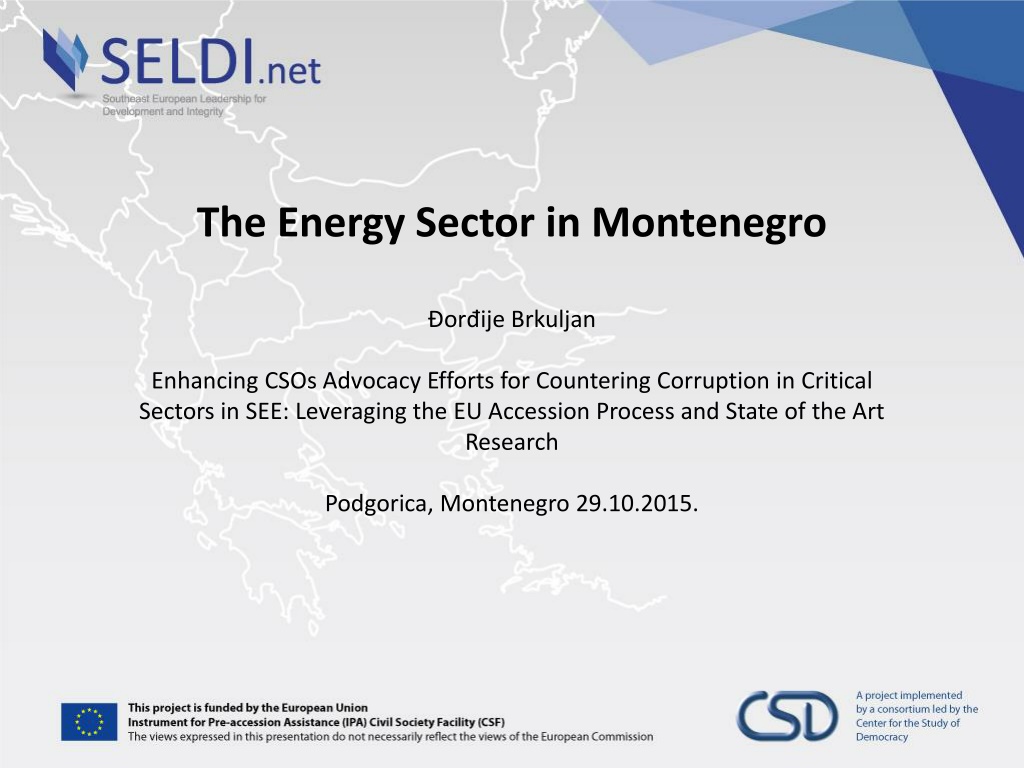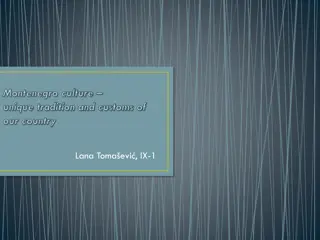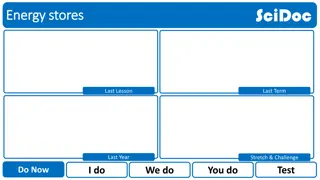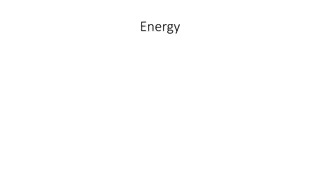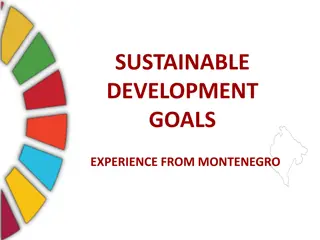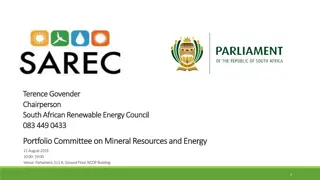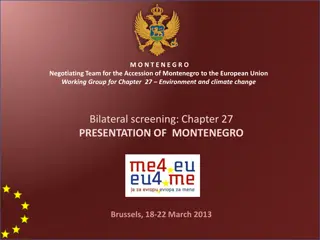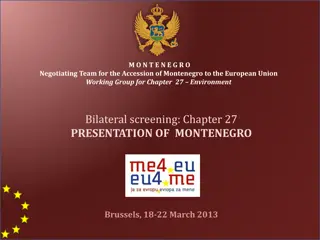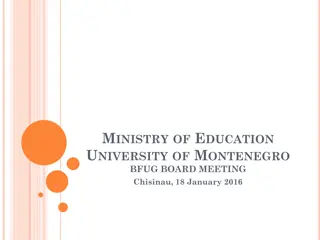The Energy Sector in Montenegro
The energy sector in Montenegro has undergone significant reforms since 2003, focusing on open market development and separating functional units within key institutions. The country's commitment to EU directives and key legislation reflects efforts to ensure competitiveness, environmental protection, and energy efficiency. The dominant presence of EPCG in the electricity sector, controlled by the State and Italian A2A, highlights the strategic partnerships shaping Montenegro's energy landscape.
Download Presentation

Please find below an Image/Link to download the presentation.
The content on the website is provided AS IS for your information and personal use only. It may not be sold, licensed, or shared on other websites without obtaining consent from the author.If you encounter any issues during the download, it is possible that the publisher has removed the file from their server.
You are allowed to download the files provided on this website for personal or commercial use, subject to the condition that they are used lawfully. All files are the property of their respective owners.
The content on the website is provided AS IS for your information and personal use only. It may not be sold, licensed, or shared on other websites without obtaining consent from the author.
E N D
Presentation Transcript
The Energy Sector in Montenegro or ije Brkuljan Enhancing CSOs Advocacy Efforts for Countering Corruption in Critical Sectors in SEE: Leveraging the EU Accession Process and State of the Art Research Podgorica, Montenegro 29.10.2015.
Key institutions in the national energy system Ministry of Economy as the main institution responsible for energy sector Energy Regulatory Agency (RAE) Operator on the electricity market (COTEE) Energy Company (EPCG) functional units Montenegrin Transmission System (CGES) Coal Mine Pljevlja (RUP) with its four
Energy sector reforms in Montenegro Energy sector reforms in Montenegro were initiated in 2003 with adoption of the first Energy Law The Law provided development of an open market concept within the energy sector These processes entailed transformation of the only energy supplier Company - EPCG) in four separated functional units. a basis for further (Montenegrin Energy
Energy sector reforms in Montenegro An independent regulatory agency (Energy Regulatory Agency RAE) was established (RAE) is the single authority for regulating the energy sector in Montenegro. RAE is governed by the Board, consisting of three members nominated by the Parliament, and Director nominated by the Board, after obtaining a positive opinion of the Government. and Deputy Director, Montenegro became member of Energy Community (EC) in 2006.
Energy sector reforms in Montenegro By signing the Treaty Montenegro committed to the implementation of directives in area of: Energy Electricity Gas Environment Renewable Energy Environment protection Competitiveness
Energy sector reforms in Montenegro Key legislation: Energy Law Energy Efficiency Law Law on Hydrocarbons Law on Spatial Development and Construction of Facilities Environmental Protection Law Exploration and Production of
Electricity EPCG (which performs generation, distribution and supply activities) dominates in the electricity sector, and it is controlled by the State (55% of the shares) and the Italian A2A (43.7% of the shares) The transmission system operator Montenegrin Electric Power Transmission belongs to the State (55% of the shares), the Italian TERNA (around 22%) as well as several investment funds System (CGES)
Electricity The electricity market operator COTEE is fully owned by the State. Currently there are 25 registered market participants, among which are 22 traders, two producers, two suppliers of final customers, and CGES.
Electricity challenges Creation conditions for market opening, which primarily concerns provisions of balancing energy and allocation of balance responsibility to market participants in a market-based mechanism Secondary legislation on supplier switching must be developed and enforced to ensure that eligible customers can effectively make use of their rights Unbundling of distribution
Gas Montenegro has no gas market Most likely option to bring gas to the country is the Ionian Adriatic Pipeline (IAP) project crossing Montenegro In EEC report it is noted that Montenegro has set up an appropriate legislative framework to allow the building of gas infrastructure and the evolution of market structures
Oil Montenegro is exploring for oil in the Adriatic Sea Three international oil and gas consortia replied to a tender for 13 blocks of 3,000 km2 published in August 2013 The Ministry of Economy plans to award a concession for 30 years. Currently there is no coordinating body responsible for developing an emergency oil stockholding system and there is a serious lack of the necessary short-term data on oil imports, consumption and stocks
Renewable Energy Electricity is mainly generated from hydropower As stated in EEC Report Montenegro widely failed to comply with the acquis on renewable energy Very little progress was made in the last years and significant institutional capacity is needed to ensure that the promotion of renewable energy can play an adequate role within the general energy policy objectives
Renewable Energy The entire legal framework for renewable energy in the transport sector has to be set up from scratch, including: targets potentials sustainability criteria certification scheme and a certification body incentives promotion Monitoring Efficient cooperation among many institutions will have to be urgently initiated to put Montenegro on track to fulfil the 10% target in transport by 2020.
Energy Efficiency The key State body for implementation of the energy efficiency policy is the Ministry of Economy - Directorate for Energy Efficiency No specialized agency for EE exists in Montenegro EEC report states that: Despite significant progress made in the reporting period, the finalization of certain legislation requires more efforts by Montenegro.
Environment impact Environmental Montenegro is governed by 2005 Law on Environmental Impact Assessment, amended in 2010. and 2011 The Government adopted a Decree on Projects Subject to EIA Montenegro should intensify transposing the requirements of the Large Combustion Plants and Industrial Emissions Directives into national legislation assessment (EIA) in its efforts in
Competition Competition Law in Montenegro was adopted in July 2012 and entered into force in October 2012 The Law generally follows the Energy Community competition rules. The Agency for Competition Protection (ACP) established in 2013 is entrusted to enforce the Law. No case applying competition law to the energy sector has been assessed.
Competition State aid is governed by the Law on State Aid Control adopted in May 2009, and amended in November 2011 The Law contains a definition and a general prohibition of State aid The Law establishes Commission (SACC) consisting of four members from various State institutions and the employers association, chaired by the Ministry of Finance a State Aid Control
Competition The SACC does not have the authority to order recovery of unlawfully granted aid and can only propose measures Government or the competent local authority of recovery to the Montenegro has adopted amendments to the Decree on more detailed criteria, conditions and manner of granting State aid, providing a legal basis for introducing instruments of the EU in this area. all interpretative
Competition The progress achieved in the transposition of the EU acquis by adopting new competition and State aid acts is not followed by progress in their implementation. 2014 Progress Report indicates as a very serious problem in handling Aluminum plant bankruptcy proceedings, given that this company until the second privatization was still working and was getting substantial financial aid.
Other energy issues Plans for the construction of hydropower plant on the river Tara were canceled in 2005 The built of four hydropower plants on the river Moraca: This was also condemned to fail because no investor has applied to the tender before deadline expired. In the draft of the strategic assessment of environmental impact (for the National Strategy on Climate Change draft by 2030) proposed hydropower is marked as controversial - they recommended a detailed research before the development of the proposed hydropower
Other energy issues Thermal power plant and coal mine in the city of Pljevlja: Main polluters - Health condition among inhabitants of Pljevlja is so threatened that the government was requested to announce the state of emergency in this area. Draft of the strategic assessment of environmental impact suggests putting thermal power plant out of work, which is planned by 2023 The government is working on preparation and implementation of the project for construction of second block of TPP Pljevlja: Plan is to ask for a credit in order to realize this project, while citizens through electricity bills would repay this investment In this case harmony with the EU and the European Energy Community has not been met, as the EU promotes the avoidance of the use of coal.
Other energy issues The Strategy for Energy Development of Montenegro by 2030 (SED) has identified a number of weaknesses that energy sector is faced with: high dependence on energy import, insufficient exploration of certain resources (oil, gas), energy inefficiency, and losses in transmission and distribution of electricity the uncontrolled use of biomass amortization of energy infrastructure lack of energy management in the public sector etc.
